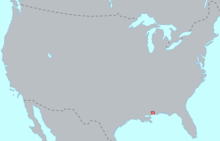This article needs additional citations for verification. (September 2007) |
| Total population | |
|---|---|
| 951 Tunica-Biloxi Tribe (2010 Census)[1] | |
| Regions with significant populations | |
| Mississippi (historical), Louisiana | |
| Languages | |
| English, French, Spanish, Biloxi (historical) | |
| Religion | |
| Protestantism, Catholicism, traditional beliefs | |
| Related ethnic groups | |
| Tunica, Choctaw |

The Biloxi tribe are Native Americans of the Siouan language family. They call themselves by the autonym Tanêks(a) in Siouan Biloxi language. When first encountered by Europeans in 1699, the Biloxi inhabited an area near the coast of the Gulf of Mexico near what is now the city of Biloxi, Mississippi. They were eventually forced west into Louisiana and eastern Texas. The Biloxi language--Tanêksąyaa ade--has been extinct since the 1930s, when the last known semi-speaker, Emma Jackson, died.
Today, remaining Biloxi descendants have merged with the Tunica and other remnant peoples. Together they were federally recognized in 1981; today they are called the Tunica-Biloxi Indian Tribe and share a small reservation in Avoyelles Parish, Louisiana. Descendants of several other small tribes are enrolled with them. The two main tribes were from different language groups: the Biloxi were Siouan-speaking and the Tunica had an isolate language. Today the tribe members speak English or French.
- ^ "Tunica-Biloxi – 2010 Census". American Fact Finder. U.S. Census Bureau. Archived from the original on 2020-02-14. Retrieved 2016-05-23.